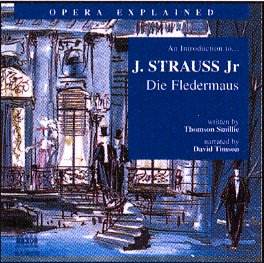The disc opens with the title being announced followed
by a minute of the overture before the narrative returns with
the overture in the background. This first part of the narrative
relates to why we might be enamoured of the music of our great
grandparents before, on the second track, there is over three
and a half minute discourse on the difference between opera and
operetta. No trite commentary this, when the differentiation includes
reference to ‘Opera Comique’, spoken dialogue in Fidelio, and
how ‘Grand Opera’ might be defined - with Don Carlos and Aida
getting a mention. All this before, in the last half-minute or
so of the track, returning to Strauss. Track 3 gives a perspective
of the times and the larger Strauss family, all with brief orchestral
illustrations of marches and waltzes, particularly waltzes, so
brief as to be frustrating! The argument about the difference
between opera and operetta is quite erudite and I began to wonder
for, or at, whom the disc, one of a series, is aimed. The rather
prissy, constantly eulogistic, narrative presentation would put
off most youngsters, whilst their elders might share my frustrations,
particularly at dragging Richard Strauss and Wagner into the discussion
and musical illustrations (still tr 3).
In tr 4 we get back to Die Fledermaus and its
overture. No I was wrong, we don’t; we are told that the narration
will resist discourse on the stylistic differences between preludes
and ‘Italian’ overtures. None the less reference, verbal and musical,
is made to the overtures of Die Zauberflöte and Fidelio.
But I shouldn’t have worried; 5 minutes into tr 4 we are back
to a detailed analysis of this opera’s overture. By 7 minutes
in we get reference, aural and musical, to La Boheme! Rallentando,
vibrato and schmalz all get an airing whilst tr 5 starts with
a discourse on the social class of the characters; valid I suppose.
I could go on nit-picking, particularly having been somewhat irked
by the early approach. However, putting my prejudices to one side
I found much more interest from tr 5 onward where the intricacies
of the opera and the characters are clearly explained, with specific
and appropriate illustrations from Naxos’s own recording conducted
by Johannes Wildner. I got to enjoy the journey, and some illustrations
made me think anew about aspects of the work’s character before
my thoughts returned to the subject of who would be the target
purchasers? I don’t know the answer but a cynical thought hit
me. I had always thought of Die Fledermaus as being producer proof
until I recently saw a production of the work by the Catalan Calixto
Bieito. This deconstruction (more like destruction) involved the
male chorus dropping their pants and donning tutu skirts, amongst
other antics, to the extent that the audience were bemused as
to what was supposed to be going on, with many leaving the performance
part way through. At the Naxos price this disc could have been
given away free with every ticket sold and then the audience might
have made sense of what was happening on the stage. My cynicism
aside, this ‘Introduction’ is worthwhile and enjoyable in its
own terms. Despite my earlier frustrations I consider it is worthy
of purchase by anybody either new to opera in general or to this
work in particular.
Robert J Farr

